8 Best Free AI Resume Builders for 2025 (ATS-Friendly & Easy)
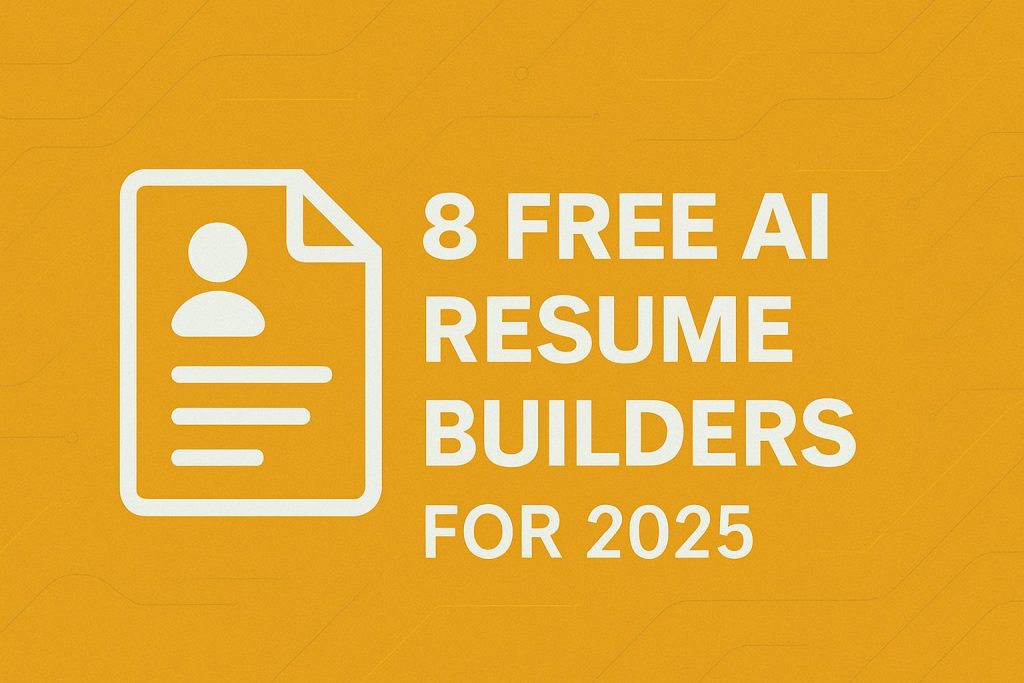
Sending your resume to hundreds of companies and still not getting shortlisted for an interview? You might start wondering if it’s you, or if your resume just isn’t impressing HRs. The truth is, most resumes never even reach human eyes. They get filtered out by software – not because you’re unqualified, but because your resume isn’t built to pass the test. In this list, you’ll find the 8 best free AI resume builder platforms that actually work. If you’re searching for a resume builder that’s easy to use, ATS-friendly, and free, keep reading. You can also read our detailed guide on how to make a perfect resume that clicks every time to further strengthen your job applications. What is an AI Resume Builder? An AI resume builder uses artificial intelligence to automatically enhance your resume content, optimize it for ATS systems, and suggest stronger summaries, skills, and phrasing to improve your chances of shortlisting. Best Online AI Resume Builder Websites Looking for a solid way to build your resume? We’ve rounded up the top 8 online AI resume builder websites that truly get the job done. 1. Abekus Looking for a job is already tough; your resume shouldn’t make it harder. Abekus offers a completely free online AI resume builder that cuts the confusion and helps you create a strong, job-ready resume in just a few clicks. What People Like About It: Modern, ATS-friendly templates that pass hiring systems and impress recruiters. One-Click Parsing of any existing resume, completes the profile in 30 seconds! Automatic AI Enhancements to improve descriptions while fixing any spelling or gramatical errors. Compact formatting to fit all your skills on a single page without clutter. Who Is It For: Freshers building their first resume Professionals switching roles Freelancers seeking stable gigs Students applying for internships Anyone tired of outdated resume builders Try Abekus Resume Builder Free → 2. Kickresume Kickresume isn’t just another free resume builder. Its templates look clean yet personal, and it pulls in real resume examples from successful applicants at top companies to guide your writing. What People Like About It: Resume examples from people hired at Google, Tesla, Amazon, and more. AI assistant rewrites phrases and fills blanks with context-based suggestions. Built-in grammar check and word choice assistance. Resume analytics comparing your document against other users. Export in multiple formats, including PDF, without formatting errors. Who Is It For: Students applying for internships Professionals refreshing old resumes Applicants targeting top brands People who feel stuck writing impactful bullets 3. Canva Most people know Canva for posters and social media, but its resume builder is a hidden gem. You get full creative control with drag-and-drop design, without needing design skills. What People Like About It: Massive template library for tech, teaching, creative, and corporate jobs. Edit everything – colors, fonts, icons, layouts. Built-in photo editing for profile pictures. Exports high-quality PDFs without watermarks. Option to animate resumes for portfolio use. Who Is It For: Creatives wanting visual resumes (designers, marketers) Freelancers pitching services visually Students looking for modern free templates Anyone bored of rigid Word templates 4. Zety Zety’s free online resume builder focuses on helping you write better content, not just layout selection. It guides you sentence by sentence with real-time suggestions. What People Like About It: AI suggestions for each resume section so you’re never stuck. Built-in spell check and formatting alerts. Resume score tracker rates your document on structure and keywords. Pre-written bullet points tailored for specific job titles. Matching cover letter builder with tone guidance. Who Is It For: Job seekers struggling to write resume content First-time applicants needing structured help Mid-level professionals wanting polished resumes quickly Users preferring word-driven resumes over visual-heavy designs 5. VisualCV VisualCV is ideal for job seekers wanting to stand out, especially when applying internationally. It’s more than a resume builder – you can track views and downloads for each version of your resume. What People Like About It: Create multiple resume versions with trackable links. Clean, formal templates used by consultants and global professionals. Add multimedia like videos, links, and slides. Offers international resume formats (Europe, Canada). Paid plans provide analytics on view times and devices. Who Is It For: Consultants and freelancers showcasing projects Professionals applying abroad needing region-specific formats Applicants tracking resume performance outside LinkedIn Portfolio builders combining resumes and work samples 6. Resume Genius Resume Genius is a free online resume builder built for speed and simplicity. Answer a few quick questions, and it creates your resume live as you go. What People Like About It: AI suggests professional bullet points by industry and role. Takes under 10 minutes for most users to complete. ATS-friendly layouts with no extra formatting needed. Huge sentence bank for inspiration. Cover letter pairing tool that mirrors your resume’s tone. Who Is It For: Anyone needing a fast, polished resume Job seekers stuck on wording Freshers and entry-level applicants needing structure People applying to corporate jobs needing formal layouts 7. Resume.io Resume.io helps you manage your entire job search in one dashboard. Build, edit, store, and track multiple resumes seamlessly. What People Like About It: Build multiple resumes and cover letters in one place. Writing guides for each section. Resume and cover letter analytics for premium users. ATS-friendly layouts that display well on mobile. Direct export to PDF or share via trackable links. Who Is It For: Applicants reapplying with different job titles Users managing multiple resume versions People preferring organized dashboards over scattered files 8. MyPerfectResume MyPerfectResume is a guided tool that walks you through each section with role-based suggestions, ideal for those needing structured help. What People Like About It: Question-based AI walkthrough adapts to your role and industry. Real-time writing suggestions for every section. Built-in spell check and formatting alignment. Live preview as you build. Includes interview tips, downloadable templates, and salary comparisons. Who Is It For: Mid-level professionals wanting guided writing help Career switchers rewriting resumes for new roles People re-entering the workforce after a gap Anyone preferring a
7 Powerful Strategies to Boost Employee Engagement in the Workplace
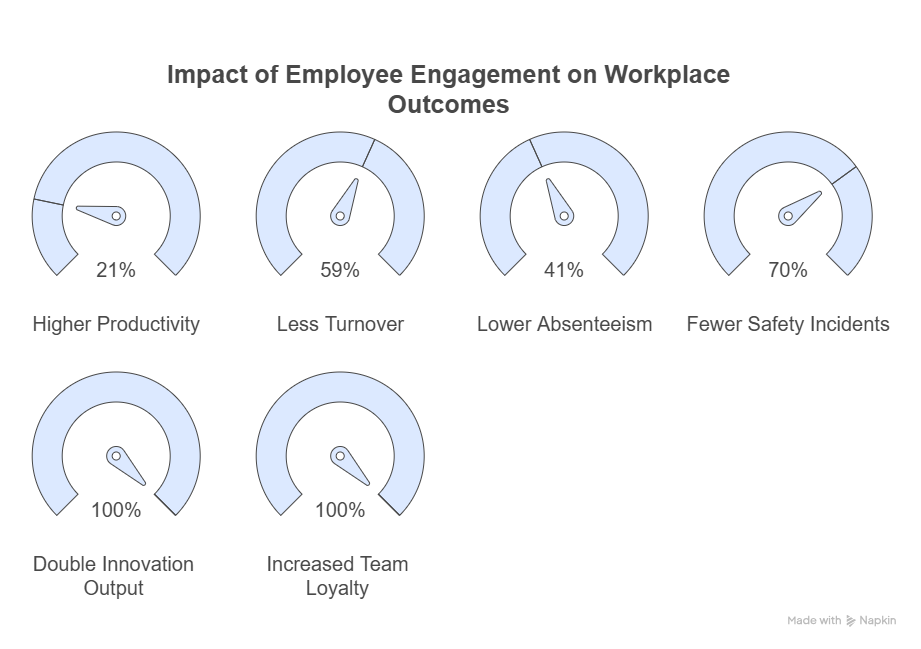
In today’s office culture, how people feel about their work is no longer a side topic, it’s central to business strength. Employee engagement isn’t just about satisfaction; it’s about how connected someone feels to their team, their manager, and the work they do every day. When employee connectivity and staff engagement are strong, it shows up in how teams think, act, and stay. This article breaks down what that really looks like and how any workplace can move from just functioning to genuinely thriving. The Business Case for Engagement When people genuinely care about their work, it shows up in the numbers. From how long employees stay to how often they speak up with better ways of working, staff engagement has a measurable impact on nearly every part of a company’s success. Why engagement in the workplace deserves attention: Companies with high staff engagement report up to 21% higher productivity. Teams with stronger involvement have 59% less turnover, especially in high-pressure environments. A sense of connection and trust among employees leads to 41% lower absenteeism. Workplaces with stronger emotional commitment see 70% fewer safety incidents. Innovation flows faster when employees feel valued, companies with higher employee engagement report double the innovation output compared to others. Strong engagement is not about perks, managers who have weekly conversations with their teams double the chances of team loyalty. These numbers prove that focusing on engagement in workplace operations leads to stronger outcomes across productivity, safety, and innovation. Letting people feel seen, heard, and connected doesn’t just improve moods either it changes results. Who Shapes Employee Engagement? Employee engagement doesn’t sit with HR alone, it’s a shared responsibility. Leadership sets the tone by what they prioritize, how they show up, and the kind of culture they support. Their actions speak louder than strategy decks or company-wide emails. But the real spark often comes from managers. They’re the ones in daily contact, giving feedback, offering clarity, and setting the pace. A present, thoughtful manager can strengthen employee connectivity faster than any formal program. Employees themselves also play a part. Their energy, honesty, and willingness to contribute shape how the team feels. But without strong guidance, even the most committed employee can feel adrift. Key Drivers of Engagement Before diving into tactics, it’s worth highlighting some of the best practices for employee engagement that actually move the needle. What keeps people connected to their work isn’t a ping-pong table or pizza Fridays. It’s the everyday experience of how they’re treated, what they’re working on, and who they’re working with. 1. Meaningful Work People want to know their time counts. When they understand how their tasks contribute to something bigger, they show up with purpose and not just out of habit. 2. Growth Opportunities Stagnation drains energy. Whether it’s learning something new or stepping into new responsibilities, the chance to grow gives people a reason to stay curious and committed. 3. Recognition Effort without acknowledgment feels invisible. A quick “you did well” from the right person can stick longer than a yearly award. It reminds people they matter. 4. Belonging Workplaces aren’t machines, they’re communities. When someone feels like they fit in and their voice carries weight, they’re more likely to give their best without holding back. These core principles form the backbone of employee engagement strategies that actually sustain teams over time. Innovative Engagement Practices Traditional perks alone don’t hold people anymore. What really keeps teams connected is how they’re treated day to day. The most effective engagement practices are often simple, people-first changes that show respect, trust, and attention. Rethink work arrangements Allowing people to choose how and where they work, be it part-time hours, remote days, or compressed weeks, shows trust and respect for personal rhythms. This directly improves how people show up. Build mentorship into the everyday Pairing employees with mentors beyond their immediate team helps them grow faster. It opens up fresh conversations, builds confidence, and creates a stronger sense of connection beyond job titles. Encourage employee-led groups Support networks built around shared interests or experiences, like women in tech, mental health circles, or book clubs, help people connect on a personal level. These spaces often lead to better collaboration at work. Turn feedback into a habit Short, regular check-ins between managers and their team members beat formal reviews. When feedback flows naturally, people feel heard and know where they stand. Recognize small wins Consistent appreciation, even for routine contributions, keeps people invested. A quick shoutout in a team meeting or a note from a peer can go further than a yearly award. Overcoming Common Pitfalls Even well-meaning companies sometimes miss the mark. When employee engagement strategies feel forced or overbuilt, they lose trust. Keeping it real, simple, and consistent is what keeps teams tuned in over time. Don’t build programs people can’t relate to Big ideas with zero follow-through confuse teams. Keep employee engagement strategies grounded in daily work, not slide decks. Stop treating surveys as the final answer Surveys are just a starting point. What happens after the conversations and the changes, is what actually builds trust. Avoid one-size-fits-all plans Every team has its own rhythm. Team engagement strategies should leave room for personal touches, not just company-wide campaigns. Don’t rely only on managers While managers are key, peer support, senior leadership, and shared spaces also shape the employee experience. Quit waiting for yearly reviews Moments of recognition or concern should happen when they’re most needed, not on a calendar. Timing matters more than formality. Wrapping Up True employee engagement isn’t built through one-off events, it takes daily effort, clear intent, and human connection. When employee connectivity is strong, people don’t just show up, they participate, share, and stick around. Engagement in the workplace grows when teams feel heard, supported, and trusted in their everyday experience. It’s not about doing more; it’s about doing what matters with consistency and care. When that happens, people bring energy that can’t be forced and that’s when work
Imposter Syndrome at Work: What It Is and How to Overcome It

What is Imposter Syndrome at Work? Imposter syndrome at work can make even the most successful professionals feel like frauds. They may question their abilities and achievements, and fear being “found out.” But what exactly is imposter syndrome, and how can you recognize and overcome it in the workplace? Let’s break it down. Defining Imposter Syndrome The Origins of the Term Imposter syndrome was first coined in 1978 by psychologists Pauline Clance and Suzanne Imes. Initially, it was used to describe high-achieving women who felt they hadn’t earned their success. Over time, however, the term has been applied more broadly to individuals who feel like their accomplishments are undeserved. Imposter Syndrome in the Workplace Imposter syndrome in a professional setting refers to the persistent belief that one’s success is a result of luck or external factors, rather than one’s own abilities or hard work. It can manifest in various ways, including self-doubt, perfectionism, and an overwhelming fear of failure. Recognizing the Symptoms of Imposter Syndrome Self-Doubt and Perfectionism One common sign of imposter syndrome is relentless self-doubt. You might constantly feel inadequate despite your qualifications and accomplishments. Perfectionism is another symptom—setting unrealistically high standards for yourself and being overly critical when you don’t meet them. Fear of Being “Found Out” People with imposter syndrome often live in fear that they will be “found out” as frauds. This fear can prevent them from speaking up in meetings, pursuing promotions, or taking on new responsibilities. Downplaying Achievements Those suffering from imposter syndrome may dismiss their successes, attributing them to luck, timing, or help from others, rather than their own abilities and hard work. How Common is Imposter Syndrome in Professional Settings? Prevalence Among High Achievers Imposter syndrome is surprisingly common, especially among high achievers. Studies show that up to 70% of people experience imposter syndrome at some point in their careers. The Role of Work Culture and Expectations High-pressure environments, competitive work cultures, and unrealistic expectations can contribute to imposter syndrome. When the bar is set extremely high, individuals may struggle to meet or exceed expectations, triggering feelings of inadequacy. The Psychological Impact of Imposter Syndrome Anxiety and Burnout The constant fear of not measuring up can lead to chronic anxiety. Over time, this can result in burnout, as individuals push themselves to exhaustion in an attempt to prove their worth. Impact on Career Growth Imposter syndrome can prevent professionals from taking risks, applying for promotions, or even speaking up about their accomplishments. This self-limiting behavior can stunt career growth and lead to missed opportunities. Types of Imposter Syndrome The Perfectionist Perfectionists set excessively high standards and often feel disappointed when they don’t meet them. They may constantly criticize their work, even when it’s objectively excellent. The Superwoman/Superman This type believes they must excel in every role they take on, whether at work, home or in relationships. They push themselves hard, often at the expense of their well-being. The Soloist Soloists feel they must accomplish everything on their own. Asking for help is seen as a sign of weakness or incompetence. The Natural Genius Natural geniuses believe they should excel at everything without effort. When they struggle to master something, they feel inadequate and may give up quickly. Why Does Imposter Syndrome Occur at Work? The Pressure to Succeed High expectations from bosses, clients, or even self-imposed standards can lead to feelings of inadequacy when they aren’t met, fostering imposter syndrome. Lack of Role Models or Mentorship Without positive role models or mentors to guide and encourage them, individuals may feel lost and unsure of their abilities. The Comparison Trap Constantly comparing oneself to others can exacerbate feelings of inadequacy, especially in a competitive work environment. Overcoming Imposter Syndrome in the Workplace Acknowledge Your Achievements Start by recognizing and celebrating your successes. Keep a journal of your achievements, no matter how small, to remind yourself of your value. Reframe Negative Thoughts When negative thoughts arise, challenge them. Replace self-doubt with affirmations of your competence and strengths. Seek Mentorship and Support Having a mentor or supportive colleagues can make a huge difference. Open conversations about your feelings of inadequacy can help normalize the experience and provide guidance. The Role of Employers in Addressing Imposter Syndrome Creating a Supportive Work Environment Employers can help by fostering a culture of openness and encouragement. Providing positive feedback and recognizing employees’ efforts can counteract feelings of inadequacy. Encouraging Open Conversations Creating spaces for employees to discuss their challenges and feelings can help reduce the stigma surrounding imposter syndrome. Offering Mental Health Resources Providing access to mental health resources, such as counseling or workshops on self-confidence, can be crucial in helping employees overcome imposter syndrome. How to Help a Colleague Struggling with Imposter Syndrome Providing Positive Reinforcement Offer genuine compliments and reinforce your colleague’s strengths. Simple words of encouragement can go a long way. Encouraging Professional Development Encourage your colleagues to seek growth opportunities, whether through additional training or new responsibilities, to build their confidence. Creating a Collaborative Team Environment Fostering collaboration rather than competition can help ease the pressure individuals feel to prove themselves. Conclusion: Moving Beyond Imposter Syndrome Imposter syndrome is a common but manageable issue. By recognizing the symptoms, understanding its origins, and taking proactive steps, you can overcome the feelings of inadequacy and thrive in your career. FAQs What are the signs of imposter syndrome in the workplace? Common signs include self-doubt, perfectionism, fear of failure, and downplaying your achievements. Can imposter syndrome affect job performance? Yes, imposter syndrome can lead to anxiety, burnout, and reluctance to take on new opportunities, ultimately affecting job performance. How can managers help employees with imposter syndrome? Managers can offer positive reinforcement, encourage open conversations, and provide mental health resources. Is imposter syndrome more common in certain professions? Imposter syndrome is particularly common in high-achieving, competitive fields such as academia, tech, and finance. What are some long-term strategies to overcome imposter syndrome? Building self-awareness, seeking mentorship, and regularly acknowledging your achievements are key to overcoming imposter syndrome
How to Make a Transition in Your Career

Introduction: Why Career Transitions Are More Common Today Career transitions are no longer a rarity; they’ve become the norm. With shifting economic landscapes, technological advancements, and evolving personal goals, many professionals find themselves seeking new opportunities outside their original fields. Whether you’re looking for more fulfillment, a better work-life balance, or a fresh challenge, career transitions offer a chance for reinvention. But, as exciting as it sounds, the path can be daunting. In this article, we’ll explore how to effectively make a career transition while minimizing risks and maximizing success. Recognizing the Need for a Career Change Signs It’s Time for a Transition Sometimes, you just know when it’s time for a change. Are you feeling stuck, bored, or unchallenged in your current role? Do you dread Mondays more than usual? These signs can indicate that you’re no longer passionate about your work. Other factors could be burnout, lack of growth opportunities, or the desire for better alignment with your values. Personal and Professional Motivations Your reasons for a career change may stem from both personal and professional desires. Whether it’s a longing for a higher salary, flexible hours, or work that aligns with your passions, understanding your motivation is the first step in successfully transitioning. Assessing Your Current Skillset Identifying Transferable Skills When shifting careers, it’s essential to recognize the skills that can carry over. Soft skills like communication, problem-solving, and leadership are often applicable across industries. Technical skills, while more specific, can also translate if adapted correctly. Gaps Between Current Skills and Desired Industry However, some gaps may exist between what you know and what the new industry demands. Identifying these early helps you prepare for the transition more effectively. Researching New Career Paths Exploring Industries with Growth Potential Not every career transition leads to better prospects. Some industries are shrinking, while others are booming. It’s essential to research industries that offer growth potential and opportunities for advancement. Speaking to Industry Experts and Mentors A crucial part of your research should involve speaking to those already in the field. Mentors, industry experts, or even informational interviews can provide valuable insights into your target career path. Gaining New Skills for the Transition Formal Education vs. Self-Learning Depending on the career you want to move into, you may need additional education. Whether this means formal degrees, certifications, or self-taught skills through online courses, continuing your education is essential for making the leap. Leveraging Online Courses and Certifications Platforms like Coursera, LinkedIn Learning, and Abekus offer accessible ways to upskill. Many of these courses also provide certifications, which can help boost your resume. Networking During Career Transition Rebuilding and Expanding Your Professional Network When switching fields, your existing network might not be sufficient. You’ll need to expand your connections to include people in the industry you’re entering. Using LinkedIn and Other Platforms LinkedIn is a powerful tool during a career transition. You can connect with professionals in your desired industry, participate in relevant groups, and even find job opportunities. Creating a Transition Plan Setting Realistic Short-Term and Long-Term Goals A successful career transition doesn’t happen overnight. Breaking it down into short-term and long-term goals allows you to make steady progress without feeling overwhelmed. Breaking Down the Transition into Manageable Steps Start by mapping out clear steps that lead to your goal. For example, gaining a specific skill, expanding your network, or applying for a particular role can be broken down into smaller tasks. Updating Your Resume and LinkedIn Profile Highlighting Relevant Experience Tailoring your resume to focus on transferable skills and relevant experience is critical. Even if your previous roles were in a different industry, emphasize the accomplishments that align with your new career. Tailoring Your Resume for New Job Opportunities Every job posting is unique, so tailor your resume to reflect the skills and experiences the employer is seeking. Managing the Emotional Aspects of Career Transition Embracing Uncertainty and Building Confidence Career transitions often bring feelings of uncertainty. Acknowledge those fears but remain focused on the benefits. Building confidence through self-awareness and preparation will ease the anxiety. Dealing with Setbacks and Rejections Expect setbacks along the way. Whether it’s a rejection or a delayed timeline, resilience is key. Every “no” brings you closer to a “yes.” Financial Planning for Your Career Change Budgeting for Income Gaps Switching careers might mean a temporary decrease in salary or a period of unemployment. Planning for these income gaps will prevent financial strain during the transition. Investing in Professional Development Consider investing in professional development courses, certifications, or seminars that will make you a more competitive candidate. Applying for Jobs in Your New Career Path Targeting Companies Open to Career Changers Look for companies that value diverse experiences. Some organizations explicitly seek career changers for the fresh perspective they bring. Preparing for Interviews in a New Industry Prepare thoroughly for interviews by anticipating questions about your career transition and demonstrating how your skills will benefit the company. Making the Transition Smooth at Your New Job Proving Yourself in the First 90 Days The first few months in your new role are critical. Show your dedication, eagerness to learn, and ability to contribute meaningfully to the team. Continuously Learning on the Job Even after the transition, the learning doesn’t stop. Staying open to new knowledge will keep you on the path to success. Measuring Your Success After the Transition Setting Performance Metrics for Yourself Once in your new role, set performance metrics to track your growth. This could be personal milestones or feedback from supervisors. Seeking Feedback from Peers and Supervisors Constructive feedback from your peers and supervisors can guide your growth in the new role. Embracing Lifelong Learning in Your New Career Staying Updated with Industry Trends Your career transition might be complete, but your professional development never is. Stay updated with the latest industry trends to remain competitive. Investing in Long-Term GrowthContinue to invest in skills that will help you advance in your new career. Whether it’s management training or further certifications,
15 Popular Python Interview Questions

Introduction Python is one of the most in-demand programming languages due to its versatility and ease of learning. As a result, Python developers are highly sought after in the job market. Preparing for a Python-related job interview can be challenging, especially with the variety of questions interviewers might ask. In this article, we will cover 15 popular Python interview questions that will help you ace your next interview. Outline of the Article What is Python? How is memory managed in Python? What are Python’s key features? Explain the difference between a list and a tuple in Python. What is PEP 8, and why is it important? How does Python handle memory leaks? What are decorators in Python? Explain Python’s GIL (Global Interpreter Lock). What are args and kwargs in Python? Explain how exception handling works in Python. How do you manage packages in Python? What is the difference between range() and xrange()? Explain Python’s lambda function. What is the purpose of the self-parameter in class methods? What is the difference between shallow and deep copy in Python? 1. What is Python? Python is an open-source, high-level programming language that is both object-oriented and interpreted. It is widely known for its simple syntax, which makes it easier to read and write code, even for beginners. Due to its extensive libraries, Python is used in fields like web development, data analysis, machine learning, and automation. 2. How is memory managed in Python? Memory in Python is managed through an inbuilt garbage collector. This garbage collector frees up memory when an object is no longer in use. Python also uses reference counting for memory management, where every object has a reference count, and when that count reaches zero, the memory is released. 3. What are Python’s key features? Some of the key features of Python are: Easy to learn: Its syntax is simple and resembles English, making it beginner-friendly. Interpreted Language: Python code is executed line by line, which makes debugging easier. Object-Oriented: Supports object-oriented programming principles like inheritance and polymorphism. Extensive Libraries: Python has a large set of standard libraries, making it versatile for various applications. Cross-platform: Python works on multiple platforms, such as Windows, macOS, and Linux. 4. Explain the difference between a list and a tuple in Python. Lists and tuples are both used to store collections of data, but there are key differences: Mutability: Lists are mutable (i.e., elements can be changed), while tuples are immutable. Syntax: Lists are defined using square brackets [], whereas tuples use parentheses (). Performance: Tuples are faster than lists due to their immutability. Use cases: Use lists when data needs to be modified, and tuples when the data should remain constant. 5. What is PEP 8, and why is it important? PEP 8 is the style guide for writing Python code. It outlines the conventions for formatting Python code to ensure it is readable and consistent across different projects. Following PEP 8 ensures that Python code is easy to maintain, especially in collaborative environments. 6. How does Python handle memory leaks? Python handles memory leaks through its garbage collector, which automatically releases memory that is no longer referenced. However, memory leaks can still occur, particularly when there are circular references or if an object holds references to other objects unintentionally. Developers must be cautious and use tools like gc (garbage collection) and memory profilers to monitor and manage memory. 7. What are decorators in Python? Decorators in Python are a way to modify the behavior of a function or method without changing its code. They allow you to wrap another function, adding functionality before or after the main function is executed. Decorators are commonly used in frameworks like Flask and Django. 8. Explain Python’s GIL (Global Interpreter Lock). Python’s Global Interpreter Lock (GIL) is a mutex that protects access to Python objects, ensuring that only one thread executes Python bytecode at a time. This can be a limitation in multi-threaded programs, especially on multi-core systems. However, GIL is essential for memory management and helps prevent race conditions. 9. What are args and kwargs in Python? args and kwargs allow you to pass a variable number of arguments to a function in Python. args: Used to pass a variable number of non-keyword arguments. kwargs: Used to pass a variable number of keyword arguments. These features make functions more flexible. 10. Explain how exception handling works in Python. Python uses try, except, and finally blocks to handle exceptions: try: Code that might raise an exception goes here. except: If an exception occurs, this block handles it. finally: This block executes no matter what is typically used for cleanup activities. 11. How do you manage packages in Python? Packages in Python are managed using the pip tool, which is Python’s package installer. You can install, update, and uninstall packages using pip. Additionally, Python projects often uses virtualenv to create isolated environments for managing dependencies. 12. What is the difference between range() and xrange()? In Python 2, range() and xrange() are different: range(): Returns a list. xrange(): Returns an iterator that generates the numbers on demand (i.e., it is more memory efficient). In Python 3, range() behaves like xrange() from Python 2, so xrange() is no longer available. 13. Explain Python’s lambda function. A lambda function is an anonymous function in Python. It is typically used for short, simple operations that don’t require a full function definition. The syntax is: lambda arguments: expression For example, lambda x: x + 1 add 1 to x. 14. What is the purpose of the self-parameter in class methods? In Python, self refers to the instance of the class. It is used in class methods to access variables and methods associated with the object. Although self is not a keyword, it is conventionally used as the first parameter in instance methods. 15. What is the difference between shallow and deep copy in Python? Shallow Copy: Creates a new object but inserts references into the original objects. Changes made to the
What is a Project Manager & How to Become One?
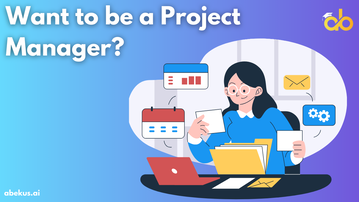
Introduction In today’s fast-paced and competitive business world, project managers play a pivotal role in ensuring the success of projects. They are the unsung heroes, quietly steering projects from conception to completion. But what exactly does it take to be a project manager? How do you become one? Let’s dive into the ins and outs of this dynamic profession. What is a Project Manager? At its core, a project manager (PM) is the person responsible for overseeing a project from start to finish. They ensure that goals are met on time and within budget. Project managers act as the bridge between the client and the team, making sure everything runs smoothly. Importance in Organizations Every successful project, no matter the industry, requires strong leadership and strategic planning. This is where a project manager comes in. Their role is crucial in making sure resources are utilized efficiently, risks are managed, and objectives are achieved. Key Responsibilities of a Project Manager Project Planning and Strategy One of the primary tasks of a project manager is creating a detailed plan that outlines the scope, timeline, and resources needed. This involves breaking down the project into manageable tasks and assigning them to team members. Budget Management Managing the financial aspects of a project is just as important. A project manager ensures that the project stays within budget while meeting quality standards. Team Leadership Leading and motivating a team is a big part of being a project manager. They ensure that everyone is aligned with the project goals and is working collaboratively to achieve them. Skills Required to Be a Project Manager Communication Skills A project manager must be an excellent communicator. They need to convey ideas clearly and ensure that everyone understands their role in the project. Time Management Staying on schedule is critical. A good project manager knows how to prioritize tasks and manage their time and the team effectively. Problem-Solving Skills No project is without its hiccups. Project managers need to think on their feet, troubleshoot problems, and find effective solutions without derailing the project. Educational Path to Becoming a Project Manager Relevant Degrees Many project managers hold degrees in business, management, or a related field. A solid educational foundation can be the first step toward mastering project management principles. Certifications (PMP, CAPM, etc.) Certifications play a significant role in building a project management career. Employers often look for candidates with recognized certifications like PMP (Project Management Professional) or CAPM (Certified Associate in Project Management). Certifications for Project Management Project Management Professional (PMP) The PMP certification is globally recognized and demonstrates that you have the experience and knowledge to lead projects. Certified Associate in Project Management (CAPM) This entry-level certification is perfect for those starting their project management journey. Steps to Becoming a Project Manager Gain Experience Start by working on small projects within your current role. This can help you build the skills and experience needed to take on larger projects. Build a Professional Network Networking with professionals in the field is key. Attend industry conferences, join project management groups, and connect with experienced PMs to learn from them. Different Types of Project Managers IT Project Manager An IT project manager focuses on tech-based projects, such as software development or system integration. Construction Project Manager In the construction industry, project managers oversee the entire building process, from planning to execution. Challenges Faced by Project Managers Managing Deadlines One of the biggest challenges is ensuring that deadlines are met without compromising the quality of the work. Conflict Resolution Managing people comes with its challenges. Project managers often find themselves resolving conflicts between team members or stakeholders. Benefits of Being a Project Manager Career Growth The career path for project managers is highly rewarding. Many project managers move into senior roles or even executive positions. High Earning Potential Project management is a high-paying career with salaries varying by industry and level of experience. Project Management Tools You Should Know Popular Software (Asana, Trello, MS Project) Project managers often rely on software to help them manage tasks, timelines, and resources. Tools like Asana, Trello, and Microsoft Project are popular in the industry. Industry Demand for Project Managers Growing Demand in Various Sectors From tech to construction, healthcare to finance, the demand for skilled project managers is on the rise. Companies need experts who can manage complex projects and deliver results. How to Stand Out as a Project Manager Continuous Learning To stay ahead in the field, project managers should continually develop their skills through workshops, courses, and new certifications. Developing Leadership Skills Being a strong leader is essential for success in this role. Building your leadership skills can set you apart from the competition. Career Growth Opportunities Moving into Senior Project Management Experienced project managers often move into senior roles, managing larger, more complex projects. Transitioning to Executive Roles With enough experience, some project managers transition into executive positions, influencing the overall strategy of their organization. Conclusion Becoming a project manager is a rewarding career choice, offering opportunities for personal and professional growth. Whether you’re just starting or looking to advance your career, mastering project management skills can open doors in virtually any industry. FAQs Do I need a certification to be a project manager? While not mandatory, certifications like PMP can give you a competitive edge in the job market. What industries need project managers? Project managers are in demand in various industries, including IT, construction, healthcare, and finance. How long does it take to become a project manager? It depends on your experience and education. With a degree and some experience, you can become a project manager within a few years. What is the average salary of a project manager? The salary varies by industry and location, but the average is around $75,000 to $100,000 annually. Can I become a project manager without experience? Entry-level project management positions may not require much experience, but gaining relevant experience through internships or smaller roles can be helpful.
How To Tackle A Career Obstacle

Introduction We all face obstacles in our careers. Challenges are a natural part of professional growth, whether it’s hitting a dead end in a role, feeling unfulfilled, or lacking the skills to advance. Overcoming these career obstacles is crucial to moving forward and realizing your true potential. In this guide, we’ll explore practical strategies to tackle your career’s roadblocks and help you become stronger on the other side. Understanding Career Obstacles Before you can tackle a career obstacle, it’s essential to understand what it is. A career obstacle is anything that stands in the way of your progress. It could be external, like a lack of opportunities in your field, or internal, such as self-doubt or a lack of necessary skills. Common Types of Career Obstacles Stagnation: Feeling stuck in your current position without a clear path forward. Lack of Skills: Realizing your current skill set isn’t enough to reach your career goals. Workplace Conflicts: Navigating office politics or conflicts with colleagues and supervisors. Personal Limitations: Dealing with self-doubt, low confidence, or mental blocks that hinder your performance. Recognizing the Signs Often, we don’t realize we’re facing an obstacle until it’s too late. Recognizing the signs early is the first step toward overcoming them. If you’re feeling demotivated, constantly frustrated, or unsure about your career direction, these may be signs that you’re dealing with a career obstacle. Ignoring these signs can lead to stagnation or even burnout. Don’t let denial keep you from addressing the problem head-on. Self-Assessment: The First Step Before you can take action, it’s important to take a step back and assess your situation. Self-reflection helps you identify the root cause of the issue. Ask yourself: What is holding me back? Am I in the right field or position for my long-term goals? Are there external or internal factors affecting my progress? Answering these questions honestly will give you clarity and help you formulate a plan to move forward. Setting Clear Goals One of the best ways to overcome a career obstacle is by setting clear, actionable goals. Without a plan, it’s easy to feel overwhelmed and directionless. Set your goals using the SMART framework—Specific, Measurable, Achievable, Relevant, and Time-bound. By breaking your goal into smaller, manageable steps, you’ll feel more in control of your career journey. Looking for a job that matches your skills and passion? Visit Jobs by Abekus. Skill Building and Development If your career obstacle stems from a lack of skills or knowledge, it’s time to invest in yourself. Whether it’s learning a new technical skill, improving your communication abilities, or becoming a better leader, skill development is key to moving past obstacles. Ways to Build Your Skills Online Courses: Platforms like Coursera, Udemy, or LinkedIn Learning offer a range of professional courses. Mentorship: Seek out a mentor who has overcome similar challenges. Networking: Attend industry events or join professional groups to expand your knowledge and connections. Seek Guidance and Support Sometimes, it’s hard to tackle obstacles alone. This is where having a mentor or career coach can be incredibly helpful. They offer a fresh perspective, provide guidance, and can keep you accountable. A strong support network—including friends, family, and colleagues—can also offer encouragement and advice during tough times. Stay Resilient and Adaptable Resilience is the ability to bounce back from challenges. Developing resilience means staying flexible and adaptable, even when things don’t go as planned. Remember, setbacks are temporary. By keeping a positive mindset, you’ll be better equipped to navigate challenges and find new opportunities. Creative Problem-Solving Techniques When faced with a seemingly unsolvable problem, it’s time to get creative. Creative problem-solving means looking at challenges from different angles and thinking outside the box. A solution-oriented mindset will help you approach career obstacles as opportunities for growth. Challenge yourself to think differently, and don’t be afraid to try unconventional approaches. Addressing External Challenges Sometimes, your career obstacles come from external factors, like difficult workplace dynamics. Whether you’re dealing with a tough boss, competitive colleagues, or a negative work environment, you need to find strategies to rise above these challenges. Open communication, active listening, and setting boundaries are essential for managing conflicts and maintaining professionalism. Career Transition as a Solution In some cases, the best way to tackle a career obstacle is by making a transition. If you’re feeling unfulfilled or stagnant, it might be time to consider changing roles, companies, or even industries. Planning a career transition can be daunting, but with a clear plan and proper research, it can lead to a more fulfilling and successful career. Work-Life Balance Personal life and career are deeply interconnected. If you’re struggling with your work-life balance, it may be affecting your career progression. Focus on setting boundaries, managing stress, and maintaining a healthy balance to ensure long-term success and well-being. The Importance of Patience and Persistence Success rarely happens overnight. Tackling career obstacles requires patience, persistence, and the ability to celebrate small victories. Even small steps in the right direction can lead to big changes over time. Learning from Failure Every failure is a stepping stone to future success. If you’ve encountered setbacks or made mistakes, don’t be discouraged. Use these experiences to grow and learn. Failure is part of the process, and those who learn from it are more likely to succeed in the long run. Conclusion Career obstacles are inevitable, but with the right mindset and strategies, they can be overcome. Whether it’s addressing skill gaps, seeking mentorship, or embracing creativity, the key is to stay resilient and adaptable. Remember, every challenge is an opportunity to grow and develop professionally. FAQs What is a career obstacle? A career obstacle is anything that blocks your progress or growth in your professional life, such as a lack of skills or workplace conflicts. How can I recognize a career obstacle? Signs include feeling stuck, unmotivated, or unsure of your career direction. Self-reflection can help identify the root cause of the problem. How do I set goals to overcome obstacles? Use the SMART
Is Working in a Start-up Worth It?

In recent years, startups have become a significant part of the global economy, driving innovation and disrupting traditional industries. The allure of working in a startup—being part of something new, exciting, and potentially groundbreaking—attracts many professionals. But the big question remains: Is working in a startup worth it? Understanding the Startup Culture Before discussing the pros and cons, it’s crucial to understand what defines a startup. Startups are typically young companies, often in the tech sector, that are developing scalable and innovative products or services. Unlike established companies, startups operate in a more fluid, fast-paced environment where change is constant. Startups are known for their distinct culture, which usually includes a casual work environment, flat organizational structures, and a focus on innovation. Unlike traditional companies, startups often lack rigid hierarchies and bureaucratic processes, giving employees more freedom to explore ideas and take on diverse roles. Advantages of Working in a Startup Learning Opportunities Startups offer unparalleled learning opportunities. Due to their small size, employees often wear multiple hats, which allows them to gain experience in various aspects of the business. Whether it’s marketing, product development, or customer service, working in a startup can provide a well-rounded experience. Growth Potential Startups can be a goldmine for those seeking rapid career advancement. With fewer employees, there’s often more room to climb the ladder quickly, especially if the startup experiences fast growth. High performers are likelier to be noticed and rewarded in a startup environment. Close-Knit Team Environment Startups usually have smaller teams, which fosters a sense of camaraderie and collaboration. Employees work closely with the founders and leadership team, providing a unique opportunity to learn directly from experienced entrepreneurs. Autonomy and Ownership In a startup, employees often have more autonomy and ownership over their work. This level of responsibility can be incredibly fulfilling, as your contributions directly impact the company’s success. The sense of ownership can also lead to greater job satisfaction. Innovative Work Environment If you’re passionate about innovation, a startup is the perfect place to be. Startups thrive on new ideas, and employees are encouraged to think outside the box. This environment can be exhilarating for creative thinkers and problem solvers. Stock Options and Financial Upside Many startups offer stock options as part of their compensation packages. While this can be risky, it also presents the potential for significant financial rewards if the company succeeds. Employees who join a startup early on can benefit from the company’s growth. Challenges of Working in a Startup Job Stability and Security One of the most significant drawbacks of working in a startup is the lack of job stability. Startups are inherently risky, and many fail within their first few years. This uncertainty can be stressful, especially for those who prefer a more stable career path. Work-Life Balance Startups are known for their demanding work environments. Long hours and weekend work are common, which can lead to burnout if not managed properly. Employees need to be prepared for the intense workload that often comes with working in a startup. Limited Resources Unlike established companies, startups often operate on tight budgets. This can mean fewer resources, such as limited staffing, lower salaries, and fewer benefits. Employees may need to be resourceful and creative to get things done with what they have. High-Pressure and Fast-Paced Work Environment The fast-paced nature of startups can be both exciting and overwhelming. The pressure to perform and meet tight deadlines is a constant challenge. While this environment can be stimulating for some, it may not be suitable for everyone. Unclear Career Progression In a startup, career paths may not be as clearly defined as in larger organizations. This ambiguity can be frustrating for those who prefer a structured career trajectory. Employees need to be comfortable with the uncertainty and potential lack of long-term career plans. Is It Right for You? Deciding whether to work in a startup ultimately depends on your career goals, personality, and risk tolerance. Startups can be incredibly rewarding for those who thrive in dynamic, fast-paced environments and are willing to take on significant challenges. Assessing Your Career Goals Consider what you want to achieve in your career. If rapid growth, innovation, and the potential for high rewards appeal to you, a startup might be the right fit. However, if you value stability, a clear career path, and work-life balance, you might want to think twice. Personality Fit Your personality plays a significant role in determining whether you’ll thrive in a startup. Are you adaptable, resilient, and comfortable with uncertainty? Do you enjoy taking initiative and solving problems? If so, a startup could be an exciting opportunity. Long-Term vs. Short-Term Benefits Think about whether you’re looking for short-term gains or long-term stability. Startups can offer quick advancement and the potential for significant financial rewards, but these benefits come with risks. Weighing the pros and cons is crucial to making an informed decision. Personal Stories: Insights from Startup Employees Hearing from those who have worked in startups can provide valuable insights. Some employees thrive in the fast-paced, innovative environment and go on to achieve great success. Others may find the pressure and uncertainty challenging and eventually transition to more stable careers. One former startup employee shared, “Working in a startup was a rollercoaster ride—exciting, but also exhausting. I learned a lot, but ultimately, I realized I needed more stability in my life.” Another noted, “I loved the autonomy and the chance to work on groundbreaking projects. It was the most fulfilling experience of my career, despite the challenges.” Comparing Startups with Corporations To make an informed decision, it’s essential to compare the startup experience with that of working in a larger corporation. Corporations often offer more stability, clearer career paths, and better benefits. However, they may lack the excitement and rapid growth opportunities found in startups. Benefits of Working in a Corporation Job Security: Corporations tend to offer more stability and long-term career prospects. Structured Environment: Clear hierarchies and established processes can provide a more predictable work
How to Give a Presentation in the Office
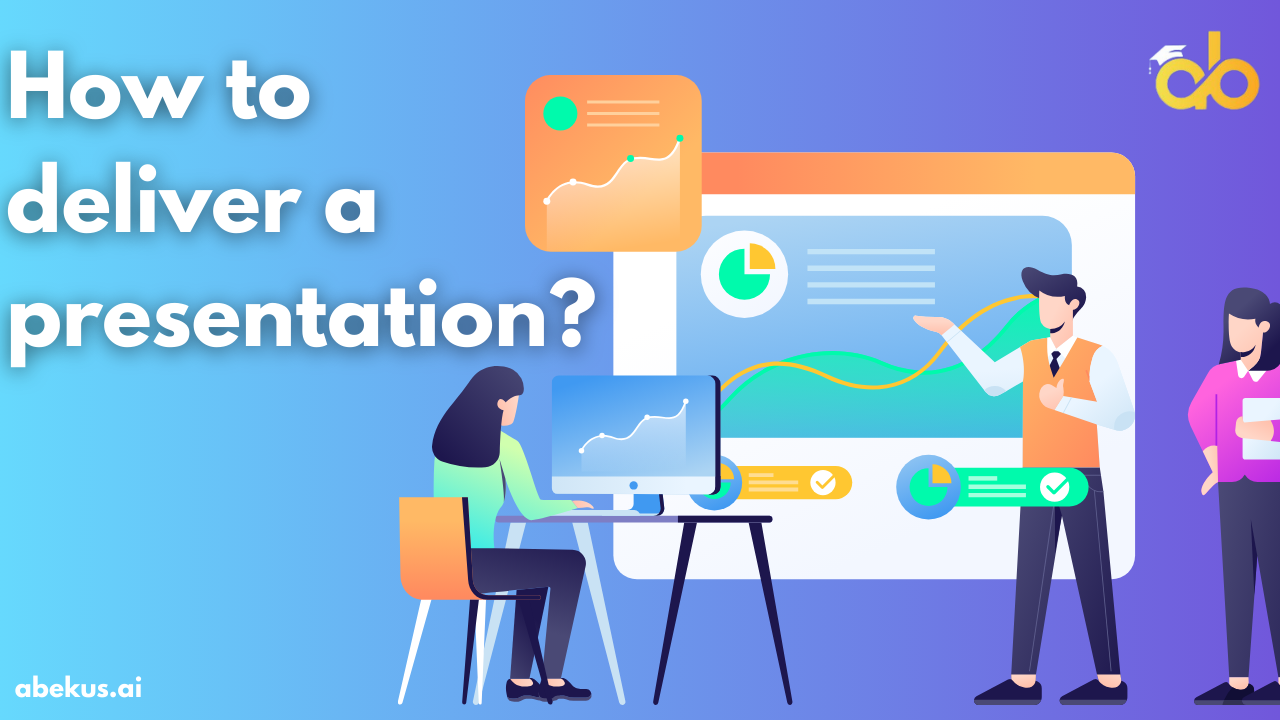
Introduction Giving a presentation in the office can be daunting, whether you’re a seasoned professional or just starting your career. Presentations are powerful tools for communicating ideas, persuading stakeholders, and showcasing your skills. However, the fear of public speaking, the pressure to deliver a compelling message, and the desire to make a lasting impact can overwhelm the process. In this guide, we’ll break down the steps to prepare, deliver, and follow up on an office presentation. Whether presenting to a small team or a large audience, these tips will help you deliver with confidence and clarity. 1. Understand Your Audience Before you even begin to craft your presentation, take time to understand your audience. Ask yourself: Who will be attending? What are their interests and concerns? How much Do they already know about the topic? What do you want them to take away from your presentation? Understanding your audience will help you tailor your content to meet their needs and keep them engaged. 2. Define Your Purpose What is the main goal of your presentation? Are you informing, persuading, or motivating your audience? Clearly defining your purpose will help you structure your presentation and focus on the key points you want to convey. 3. Craft a Clear and Compelling Message Your presentation should have a clear message that is easy for your audience to understand and remember. This message should be: Concise: Avoid overloading your presentation with too much information. Relevant: Focus on the points that matter most to your audience. Engaging: Use stories, examples, and visuals to bring your message to life. 4. Structure Your Presentation A well-structured presentation is easier to follow and more effective. Consider using the following structure: Introduction: Briefly introduce yourself and your topic. Outline what you’ll cover. Main Content: Break down your message into 3-5 key points. Each point should have supporting evidence or examples. Conclusion: Summarize your main points and reiterate your key message. End with a call to action or a thought-provoking statement. 5. Use Visual Aids Wisely Visual aids like slides, charts, and videos can enhance your presentation by making complex information easier to understand. However, they should support your message, not distract from it. Keep slides simple and uncluttered, use high-quality images, and ensure that the text is large enough to be easily read from a distance. 6. Practice, Practice, Practice Rehearsing your presentation is key to delivering it confidently. Practice in front of a mirror, record yourself or rehearse with a colleague. Focus on your pacing, tone, and body language. The more familiar you are with your material, the more natural and confident you’ll feel. 7. Manage Nervousness It’s normal to feel nervous before giving a presentation. Here are some tips to manage your anxiety: Deep Breathing: Take deep breaths to calm your nerves. Positive Visualization: Imagine yourself delivering a successful presentation. Preparation: The more prepared you are, the less anxious you’ll feel. Focus on Your Audience: Shift your focus from yourself to how you can help your audience. 8. Engage Your Audience Keeping your audience engaged is crucial for a successful presentation. Encourage participation by: Asking questions. Inviting feedback or opinions. Using interactive elements like polls or quizzes. Maintaining eye contact and using expressive body language. 9. Handle Questions Confidently At the end of your presentation, be prepared to answer questions. Listen carefully, respond thoughtfully, and don’t be afraid to admit if you don’t know the answer. You can always offer to follow up after the presentation. 10. Follow Up After the Presentation Your presentation doesn’t end when you finish speaking. Follow up with your audience to reinforce your message and address any remaining questions. Send a summary of your key points, provide additional resources, or schedule a follow-up meeting if necessary. 11. Reflect and Improve After your presentation, take time to reflect on what went well and what could be improved. Consider asking for feedback from colleagues or your audience. Use this feedback to refine your skills for future presentations. Conclusion Giving a presentation in the office is an opportunity to showcase your expertise, communicate your ideas, and make a positive impression on your colleagues. By understanding your audience, crafting a clear message, and practicing your delivery, you can overcome your fears and deliver a presentation that is both engaging and effective. FAQs 1. How do I overcome the fear of public speaking? Practice regularly, focus on your message, and use relaxation techniques like deep breathing to manage anxiety. 2. How can I make my presentation more engaging? Use visuals, tell stories, and encourage audience participation to keep your audience engaged. 3. What if I forget my lines during the presentation? Pause, take a deep breath, and continue. It’s okay to refer to your notes if needed. 4. How can I ensure my presentation is effective? Understand your audience, have a clear purpose, and practice thoroughly. 5. What if I don’t know the answer to a question? Be honest, and offer to find out the answer and follow up after the presentation.
11 Things to Remember on Your First Day at the Office
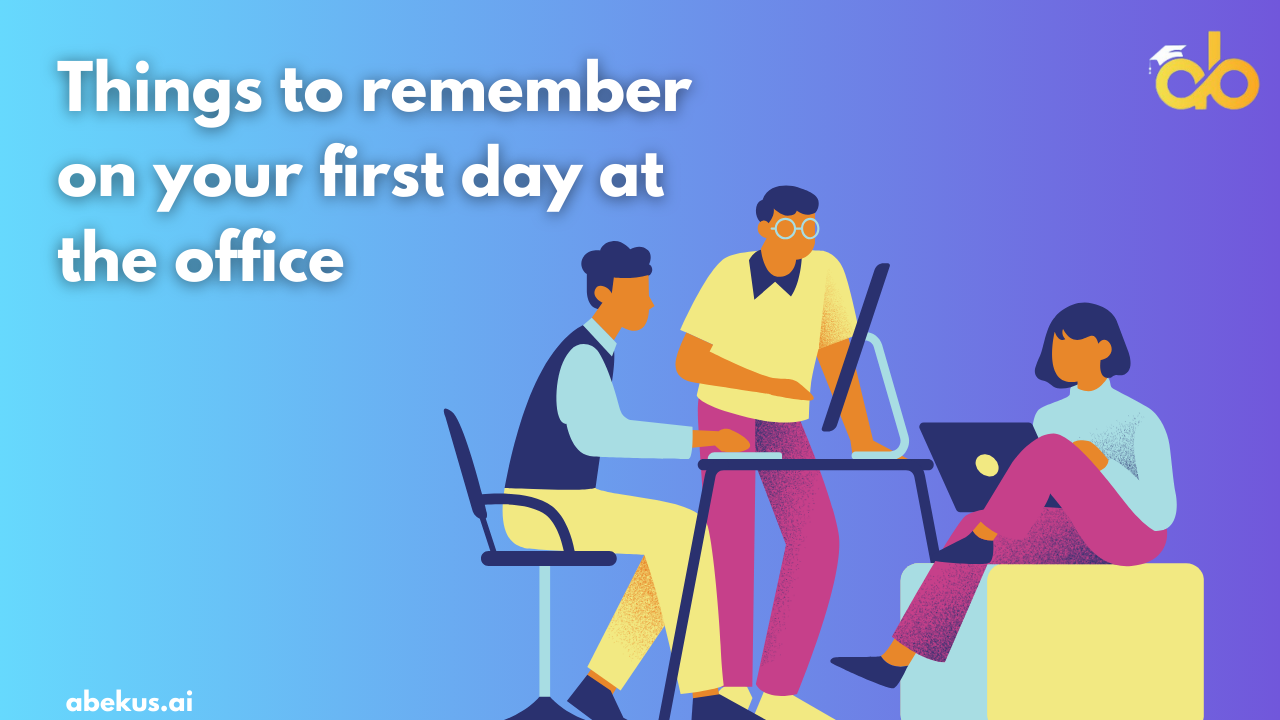
Introduction Your first day at a new job is crucial. It’s your opportunity to make a lasting impression, start building relationships, and set the tone for your time with the company. Whether you’re feeling nervous or excited, a little preparation can go a long way. Here’s a guide to help you navigate your first day at the office with confidence. 1. Prepare Your Documents Before you step into the office, make sure you have all your documents in order. This includes any identification, employment forms, or contracts you may need to submit. Having these ready not only shows your professionalism but also helps you avoid any unnecessary stress on your first day. 2. Dress Appropriately First impressions matter, and how you dress is a big part of that. Research the company’s dress code ahead of time, whether it’s business casual or formal. Choose an outfit that’s professional but also comfortable enough to wear all day. Remember, it’s better to be slightly overdressed than underdressed. 3. Arrive Early Plan your commute and aim to arrive at least 15 minutes early. This gives you time to settle in, calm your nerves, and make a good first impression. Being punctual shows that you’re serious about the job and respect the company’s time. 4. Be Ready to Introduce Yourself You’ll likely meet a lot of new people on your first day, so be prepared with a brief, confident introduction. Practice a short pitch about who you are, your role, and a little about your background. A strong introduction can set the tone for your professional relationships. Related: Jobs by Abekus – An AI recruitment platform that suggests jobs according to your skills and interests. 5. Bring a Notebook Taking notes is essential on your first day. You’ll receive a lot of information, and it’s easy to forget details. A notebook helps you keep track of everything from meeting schedules to key contacts. Plus, it shows that you’re organized and attentive. 6. Listen More Than You Speak Your first day is more about listening than talking. Pay close attention to what your managers and colleagues are saying, and absorb as much information as possible. Active listening will help you understand the company’s processes and expectations. 7. Be Open to Learning Every company has its way of doing things, so be prepared to learn. Embrace the learning curve and don’t be afraid to ask questions. Showing that you’re eager to learn and adapt is a quality that employers value. 8. Understand the Company Culture Company culture is the heartbeat of any organization. Take the time to observe your surroundings and understand how things operate. This includes everything from communication styles to break times. Aligning yourself with the company’s culture will help you fit in and succeed. 9. Get to Know Your Colleagues Building relationships with your colleagues is key to a positive work experience. Introduce yourself, show interest in their roles, and try to learn as much as you can from them. Networking on your first day can set the foundation for strong professional relationships. 10. Stay Positive and Enthusiastic A positive attitude goes a long way. Even if you feel overwhelmed, staying positive and enthusiastic will make a great impression on your new colleagues. Enthusiasm shows that you’re excited about the opportunity and ready to contribute. 11. Reflect on Your Day At the end of your first day, take a few moments to reflect. Review what you’ve learned, identify any areas where you need more information, and plan for the days ahead. Reflection helps solidify your learning and prepares you for success in your new role. Conclusion Your first day at the office is a significant step in your career. By following these tips, you can navigate it smoothly and set yourself up for success. Stay confident, be prepared, and remember that everyone was once new too. FAQs What should I bring on my first day? Bring any required documents, a notebook, a pen, and a positive attitude. How can I calm my nerves before my first day? Prepare thoroughly, plan your route, and remind yourself that it’s normal to feel nervous. Is it okay to ask questions on the first day? Absolutely! Asking questions shows that you’re eager to learn and get things right. How should I introduce myself to my new colleagues? Keep it brief and confident. Mention your role, and your background, and express enthusiasm for the new job. What if I make a mistake on my first day? Don’t worry! Mistakes are part of the learning process. Just stay positive and be open to feedback.

